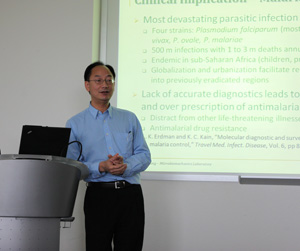Cell Mechanics
Cells share several traits with mechanical structures. Both incorporate tubes, rods and cables; both exert push-and-pull forces; and both adhere to a substrate of some type. Biomedical engineering professor William Tang is using those similarities as a way to better understand cellular behavior.
|
His research group is developing microfluidic platforms – tiny devices through which blood and other fluids flow – that can mathematically quantify the mechanical behaviors of cells. By understanding how fast and in which direction those cells move, how their shapes and flexibility change and the amount of force they exert, scientists can more easily identify which are disease-infected. Tang, a SURF-IT mentor, this week presented the second tutorial in the SURF-IT Summer Seminar Series.
Studying the mechanical activity of cells allows researchers to “better understand cell behaviors beyond just looking at them through a microscope and using chemicals to study their biochemical behaviors,” he told the audience. His approach involves building tiny “bridges” from zinc oxide, a material that is piezoelectric, meaning it can convert mechanical force into electrical force and vice versa. Applying an alternating electric field across the bridge causes it to vibrate, turning it into a variable resistor. The frequency and amplitude of these vibrations will differ, based on what materials are flowing across the bridge, he explained. Scans of the bridge before and after cells are placed on it yield information about the size and weight of the cells. Subsequent scans into higher and higher frequencies yield additional information: how fast and in what direction the cell is moving, and whether it is spreading out or rounding up. “Using this tool allows the study of cell physiology beyond what the microscope and biochemistry can tell you,” Tang said. “Knowing how the cell is behaving under certain controlled circumstances is very, very powerful.” Because the cells need constant nourishment, the bridge occupies a microfluidic “bio-reactor,” a chamber into which new sustenance is fed through sub channels while allowing the cells to remain undisturbed to continue their natural physiological functions. This work in cell mechanics bioinformatics has important implications in disease detection, especially malaria, which Tang said is responsible for approximately 240 million infections, and 850,000 deaths annually. A lack of diagnostic tools in underdeveloped countries leads to frequent misdiagnosis and over-prescription of anti-malarial drugs. This, in turn, leads to drug resistance to these medications, rendering them ineffective in actually treating malaria. Tang explained that when the malaria parasite enters red blood cells, it devours the contents of the cell and creates new parasites within it. These parasites make the red blood cells heavy, stiff and sticky, causing them to move slowly through the bloodstream. “That is ideal for our platform,” he said. “All we need to do is run the whole blood sample through the scan, and we can identify and quantify the ratio of red blood cells that are infected.” Tang’s group is working to develop an inexpensive, easy-to-use malaria detection device to replace current approaches, which are time-consuming, labor intensive, expensive and often unavailable in Third World countries. “Using the mechanical approach instead of the chemical approach gives us more possibilities for developing a diagnostic tool that can overcome all these shortcomings,” he noted. Once the detection device is perfected, Tang envisions creating a palm-sized version that utilizes disposable cartridges. “We could put a blood sample in it, plug it into a smartphone-like device for testing and then throw the cartridge away,” he said. “That is our future work.”
-- Anna Lynn Spitzer

